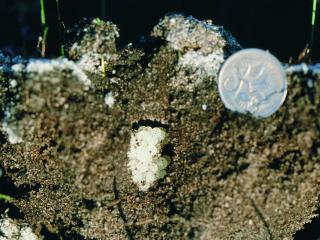Reproduction and lifecycle
An understanding of the snail lifecycle is fundamental for the effective management of the pest. Snails are hermaphrodites which means they have both male and female reproductive organs. Even though they are able to self-fertilise, most snails will mate with another snail. The garden snail reaches sexual maturity between one to two years after hatching.
Aestivation
In summer, most snails will shelter in the canopy to escape from the heat. During this time they are largely inactive and enter aestivation (dormancy). Aestivation can last from a few days to months. Snails in this state can also be found sheltering on fence posts, at the base of weeds and grasses, in trees as well as under rocks or below the soil surface.
Compared to other snail species, the common garden snail may be more active during summer. Rainfall can trigger snail activity and they may move out of the canopy to feed temporarily. Movement will depend on the type of ground cover and availability of other foods in the orchard.
Egg laying
Autumn rains and changing environmental conditions will break aestivation and trigger movement. After aestivation is broken, snails will begin to feed, mate and lay eggs.
Snails can produce up to six batches of eggs in a single year. During the mating process each snail will lay around 80 eggs about 3-6 days after mating. Each snail digs a 2–4cm hole in the soil with its foot to lay the eggs which will hatch two weeks later (Figure 3).
Most egg laying occurs in winter but can continue if the soil remains moist. The common garden snail may hibernate during winter if temperatures are too cold by burying itself in the soil or at the base of plants.
Some egg laying can still occur in spring if soil is moist. As temperatures increase, snails will begin to find a safe place for summer aestivation. Snails will increase movement into trees at this time. Cultivation or other management practices which disturb snails on the orchard floor and remove their food source will cause increased movement into trees. Populations from surrounding areas can quickly migrate in to orchards to aestivate.
Monitoring
The key to effective snail control is regular monitoring. It is necessary to estimate how many snails are present before and after applying control measures. Early identification of population growth is essential for control.
Check in the early morning or in the evening when conditions are cooler and snails are more active. The density of snail populations can vary substantially across an orchard. If there are a wide range of snail sizes in the orchard this indicates that snails are breeding but if most snails are the same size they are likely migrating into the orchard from nearby infected areas. Migration can be minimised by focusing control efforts on the boundary and neighbouring areas.

